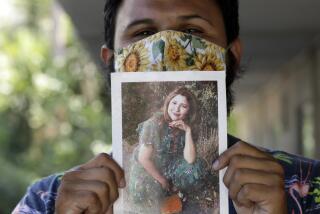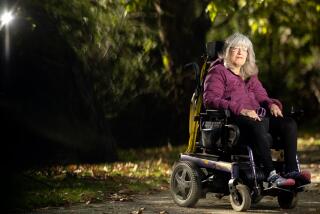Woman Crippled in Traffic Crash Wins $2.16 Million
- Share via
The City of Los Angeles must pay $2.16 million to a 21-year-old woman who was permanently disabled when the car in which she was a passenger ran a stop sign and was broadsided, a jury decided Thursday.
The Superior Court jury found that the city was partly to blame, because it had failed to properly mark the Granada Hills intersection where the crash occurred.
Although the jury found the city was only 22% liable, it is the only defendant with the resources to pay the judgment. So, under liability law, it will be required to pay the entire amount.
The jury found unnamed others 78% responsible for the crash. Several jurors said afterward that “others” included the driver of the car who, according to trial testimony, was under the influence of drugs and may never have braked.
The October, 1979, crash left Kathy Sills, then 16, brain-damaged and partly crippled. Another passenger died. The damage award to Sills came after a five-week trial and four days of jury deliberation.
The attorney defending the city expressed surprise and anger at the jury’s finding.
“I think it’s wrong,” Assistant City Atty. Philip Shiner said. “I don’t think there is anything unsafe about that intersection.”
He said the city will consider an appeal.
Shiner said no other major accidents had been blamed on conditions at the intersection. He said the city has not, nor does it plan to, make any changes at the location.
Sills’ accident occurred when she and three high school friends were returning home in the rain about 3 a.m. Sills was in the back seat as the car traveled south on Tunney Avenue toward Devonshire Street.
The driver of the car ran the stop sign and was struck by a pickup truck traveling west on Devonshire.
Jurors said they believed the intersection was unsafe because there were no signs along Tunney warning of an upcoming stop and because bushes growing on one corner--on land that is city-owned--blocked the view between the vehicles.
Testimony during the trial revealed that the driver of the car in which Sills rode was under the influence of drugs and may never have braked. However, jurors talking after they were dismissed said they believed that if he and the other driver could have seen each other coming, they could have swerved and lessened the impact of the collision.
“That intersection is still dangerous--I wish the city would go out and fix it,” juror Francis Walendziewicz said.
More to Read
Sign up for Essential California
The most important California stories and recommendations in your inbox every morning.
You may occasionally receive promotional content from the Los Angeles Times.











